|
|
|||
|
(Back to Preceding Week; on to Next Week) |
|
NATURE FESTIVALS: These days it's quite common for North American locations to hold birding and nature festivals--often in an effort to promote local tourism at times when folks might not otherwise be inclined to travel. Twenty years ago such festivals were few and far between but now almost every weekend January through December one can find an event somewhere. Several are very specific in their focus--such as the venerable HummerBird Celebration in Rockport TX or the Snake River Birds of Prey Festival near Boise ID--while others are more general. Through the years we've been privileged to participate in many festivals across the country as lecturer or field trip leader or through bird banding demonstrations. In fact, during the second half of April 2009 we were at two festivals, one focusing on nature photography and the other on the spectacle of spring migration in the Appalachian Mountains.
All text & photos © Hilton Pond Center The first event was the 2009 Florida's Birding & Fotofest (above), held this year among various sites in the vicinity of St. Augustine FL, and the Whitney Marine Laboratory. (The event is hosted by St. Augustine Ponte Vedra and neighboring beaches, in collaboration with area Audubon chapters, parks, and ecotourism companies.) Our lecture--which covered results of our Ruby-throated Hummingbird research in Costa Rica--was sponsored by Holbrook Travel, the company that handles logistics for our Neotropical hummer banding expeditions. Because nature photography was an emphasis of the Florida festival, there were many vendors from the big camera and optics companies, as well as reps from smaller firms that specialize in everything from bird recordings to field guides to devices that make field photography easier.
Workshops were led by some of the best-known bird photographers in the U.S.--Rob Sheppard, Roy Toft, Rick Sammon, Lewis Kemper, Kathy Adams Clark, Chas Glatzer, Kevin Karlson, and Greg Downing--and covered topics as general as outdoor travel tips and as specific as syncing high-speed flash modes. One of the most interesting aspects of the Florida festival was the "3rd Annual Digiscoping Summit." This series of workshops dealt with using high-powered spotting scopes--rather than traditional telephoto lenses--to make photo images of birds at long distances and on-the-wing. Alas, because we were in Florida at the behest of Holbrook, we weren't able to attend many festival sessions, but finally--after five years--we did get to visit the travel company's headquarters in Gainesville. There we met an engaging staff we knew only by e-mail and phone, and they helped work out final logistics for our upcoming tropical hummingbird banding expeditions to Costa Rica, Guatemala, and Belize. Before heading back home we also spent a great deal of time editing Holbrook's new booklet about their many bird-related trips around the world. (See booklet cover, above right, with photo of Resplendent Quetzal--Guatemala's national bird.)
All text & photos © Hilton Pond Center We did visit the beach briefly at St. Augustine where we saw almost no wildlife or people; the few artistic photos we took included a view of ghoulish, one-foot-diameter potholes in the rocks (above) and a leggy, late-afternoon self-portrait (below).
All text & photos © Hilton Pond Center After flying back from Florida, we spent one night at Hilton Pond Center and immediately drove north to our next gig, this time at the 7th Annual New River Birding & Nature Festival in Fayette County, West Virginia. We've been involved with this event since its inception and are always happy to be back in the Mountain State, whose natural splendors we have long studied, admired, and appreciated. Our affection for West Virginia goes back 45 years to 1964 when we were selected to attend the National Youth Science Camp in Pocahontas County. We revisit the state as often as we can. The New River Birding & Nature Festival was first held in 2003 to get folks into the New River Gorge area during late April and early May. Historically this was a lull time between seasons for winter snow skiing and summer whitewater rafting--two major outdoor activities essential to Fayette County's modern-day economy.
All text & photos © Hilton Pond Center Many birding festivals last only a weekend; the one at New River goes on for an entire week--Monday through Saturday, usually the last week in April. Attendees stay at Heeter's Opossum Creek Retreat or nearby hotels or cabins, rising early each morning for a smorgasbord of activities: All-day birding trips to places such as the incomparable Cranberry Glades Wilderness and Gauley River National Recreation Area; The very first bird we netted this year at Opossum Creek was one we've seldom observed on-the-wing OR in-the-hand: A migrant Lincoln's Sparrow. This LBJ ("little brown jobber")--which we neglected to photograph because we were in teaching mode--moving north toward breeding territory in Canada. We took considerable pleasure helping Festival attendees eventually identify this uncommon species by looking at its size, shape, and field marks.
All text & photos © Hilton Pond Center A few of our captures were Neotropical migrants--including a Palm Warbler (above)--on the way back from Central American wintering grounds. By week's end we had caught and banded 12 species and 22 individuals--not a ton of birds but exactly enough for us to use to teach about the hows and whys of bird banding.
Along with the New River festival's "regular" participants--who may elect to come for a day or two or stay all week--two three-day Elderhostel groups meet consecutively at nearby Hawks Nest State Park, where they make use of the facility's meeting rooms, bird-rich campus, and a tram that eases down the mountain from the lodge to the banks of the New River itself. At the bottom Elderhostelers walk an old railroad corridor to look at birds and wildflowers or ride a jetboat up and down the river to see water-loving birds such as Osprey and a Common Loon. These folks also hear presentations by Festival experts and visit Opossum Creek for bird banding. This year, there were nearly 50 Elderhostelers and more than a hundred "regular" participants--not counting the 20 or so lecturers and field trip leaders. Together, all these observers tallied 139 species, with Forster's Tern and Bonaparte's Gull among the most unexpected. (This year's bird tally, very respectable for a week plagued by rain and low cloud ceilings and the near-absence of waterfowl, was just 18 below the week-long Festival record of 157.)
All text & photos © Hilton Pond Center Bird banding and lecturing consumed most of our waking hours in West Virginia, but we did manage to sneak in a few hours of nature photography right at Opossum Creek. Our shots included several of Wild Geranium or Cranesbill, Geranium maculatum (above). We couldn't decide on a favorite, so we include two herein: One of a blossom laden with raindrops (above) and the other including a unidentified, iridescent-winged fly (below) taking its fill of geranium nectar.
All text & photos © Hilton Pond Center Although the Florida Birding & Fotofest and New River Birding & Nature Festival were great fun, it's good to be back at Hilton Pond Center--after what (especially with five weeks in Costa Rica this winter) has been a four-month period during which we were on the road far more than being at home. Nonetheless, we can hardly wait for next April, when--like millions of songbirds--the migratory urge will send us back to wild and wonderful West Virginia, the New River festival, and the splendors of Appalachian spring.
Comments or questions about this week's installment?
Thanks to the following fine folks for recent gifts in support of Hilton Pond Center for Piedmont Natural History and/or Operation RubyThroat: The Hummingbird Project. Your tax-deductible contributions allow us to continue writing, photographing, and sharing "This Week at Hilton Pond." (Please see Support if you'd like to make a gift of your own. You can also contribute by ordering an Operation RubyThroat T-shirt.)
"This Week at Hilton Pond" is written & photographed You may wish to consult our Index of all nature topics covered since February 2000. You can also use our on-line Hilton Pond Search Engine at the bottom of this page. For a free, non-fattening, on-line subscription to |
|
Make direct donations on-line via
Network for Good: |
|
|
Use your PayPal account
to make direct donations: |
|
|
If you like to shop on-line, you please become a member of iGive, through which more than 750 on-line stores from Barnes & Noble to Lands' End will donate a percentage of your purchase price in support of Hilton Pond Center and Operation RubyThroat. For every new member who signs up and makes an on-line purchase iGive will donate an ADDITIONAL $5 to the Center. Please sign up by going to the iGive Web site; more than 200 members have signed up to help. It's a painless, important way for YOU to support our on-going work in conservation, education, and research. |
|
|
SPECIES BANDED THIS WEEK: * = New species for 2009 WEEKLY BANDING TOTAL 4 species 6 individuals YEARLY BANDING TOTAL (2009) 19 species 922 individuals 28-YEAR BANDING GRAND TOTAL (since 28 June 1982, during which time 170 species have been observed on or over the property) 124 species 52,804 individuals NOTABLE RECAPTURES THIS WEEK (with original banding date, sex, and current age) American Goldfinch (1) Northern Cardinal (1) House Finch (1)
|
OTHER NATURE NOTES OF INTEREST
|
|
|
|
(Back to Preceding Week; on to Next Week) Up to Top of Page Back to This Week at Hilton Pond Center Current Weather Conditions at Hilton Pond Center |
 You can also post questions for The Piedmont Naturalist |
Join the |
Search Engine for |
|
|
Sure Fit slip covers


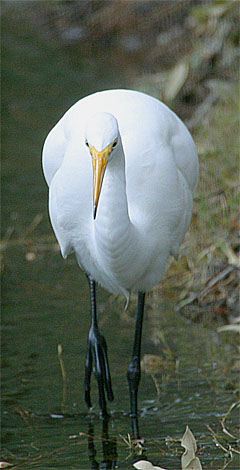 The weekend included photo tours at St. Augustine Alligator Farm Zoological Park, which expanded its native swamp exhibit in the mid-70's and "accidentally" created a place that has become one of Florida's "largest natural bird rookeries." To quote the festival booklet: "Twelve [wading bird] species frequent the [two-acre] swamp, with seven of those nesting and producing young. Great Egrets (left) and the endangered Wood Stork are first to arrive, followed by Snowy Egret, Tri-colored and Little Blue herons, and lastly, Cattle Egrets. Green Herons choose nesting spots deep within the trees in the Land of Crocodiles."
The weekend included photo tours at St. Augustine Alligator Farm Zoological Park, which expanded its native swamp exhibit in the mid-70's and "accidentally" created a place that has become one of Florida's "largest natural bird rookeries." To quote the festival booklet: "Twelve [wading bird] species frequent the [two-acre] swamp, with seven of those nesting and producing young. Great Egrets (left) and the endangered Wood Stork are first to arrive, followed by Snowy Egret, Tri-colored and Little Blue herons, and lastly, Cattle Egrets. Green Herons choose nesting spots deep within the trees in the Land of Crocodiles." The nice thing about digiscoping is even folks who have only a pocket point-and-shoot digital camera can still make usable photos through the spotting scope without the expense of an SLR camera and its requisite long telephoto lenses.
The nice thing about digiscoping is even folks who have only a pocket point-and-shoot digital camera can still make usable photos through the spotting scope without the expense of an SLR camera and its requisite long telephoto lenses.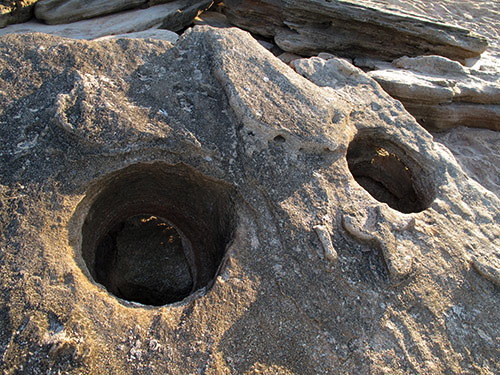
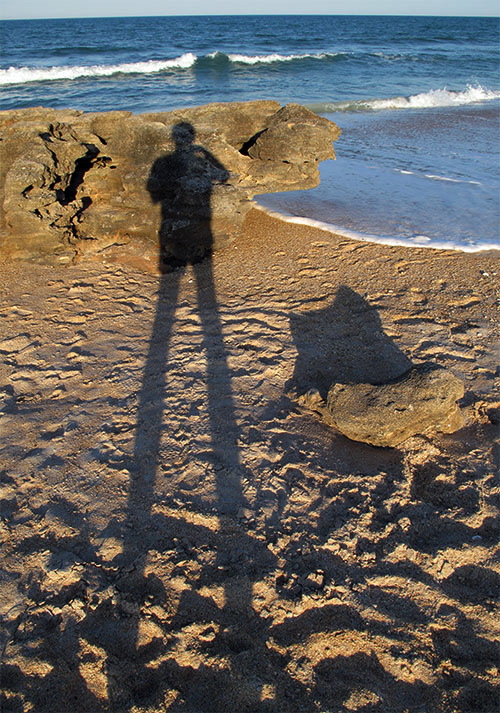
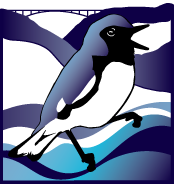 Primarily the brainchild of retreat-owner Geoff Heeter and county employee Dave Pollard (and his wife Lynn), the New River festival first focused on the amazing numbers and varieties of Neotropical bird migrants that travel along the Appalachian corridor each spring--including the Black-throated Blue Warbler on the festival's logo (above left). Today the main emphasis is still on birds but has broadened to include everything from wildflowers to mushrooms and butterflies to salamanders--all of which are plentiful in West Virginia's lush, green, central mountains.
Primarily the brainchild of retreat-owner Geoff Heeter and county employee Dave Pollard (and his wife Lynn), the New River festival first focused on the amazing numbers and varieties of Neotropical bird migrants that travel along the Appalachian corridor each spring--including the Black-throated Blue Warbler on the festival's logo (above left). Today the main emphasis is still on birds but has broadened to include everything from wildflowers to mushrooms and butterflies to salamanders--all of which are plentiful in West Virginia's lush, green, central mountains.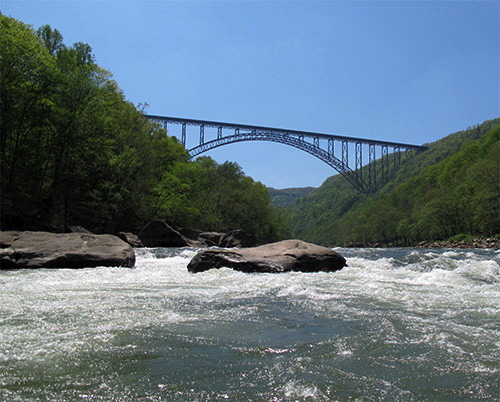
 birding by boat (within sight of the amazing New River Gorge bridge, above); and even "birding by butt" (in which folks lean back in lawn chairs to watch warbler migration in the treetops overhead). One of our personal contributions is to run mist nets and hummingbird traps at Opossum Creek, where we capture resident and migratory birds for banding and provide Festival participants with the closest possible views of species they otherwise see only through binoculars. (This year we also pointed out several bird nests, including the one above right built by a seemingly compulsive pair of Carolina Wrens. The actual nest hole is hidden in the shadows in the upper center of the photo.)
birding by boat (within sight of the amazing New River Gorge bridge, above); and even "birding by butt" (in which folks lean back in lawn chairs to watch warbler migration in the treetops overhead). One of our personal contributions is to run mist nets and hummingbird traps at Opossum Creek, where we capture resident and migratory birds for banding and provide Festival participants with the closest possible views of species they otherwise see only through binoculars. (This year we also pointed out several bird nests, including the one above right built by a seemingly compulsive pair of Carolina Wrens. The actual nest hole is hidden in the shadows in the upper center of the photo.)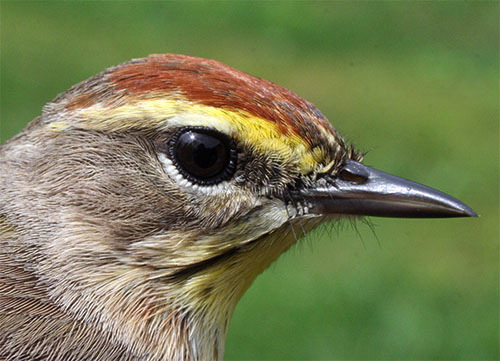
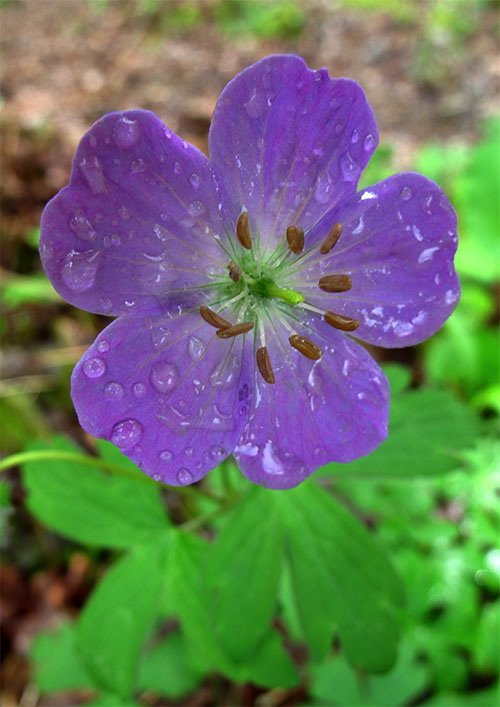
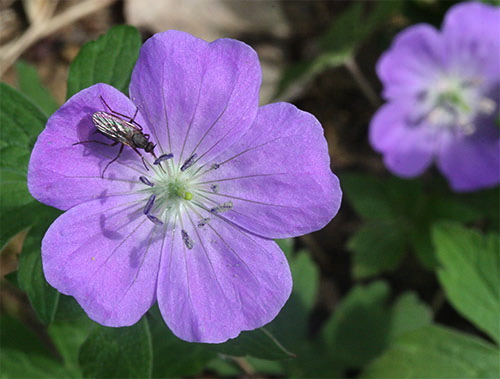


 Please report your
Please report your